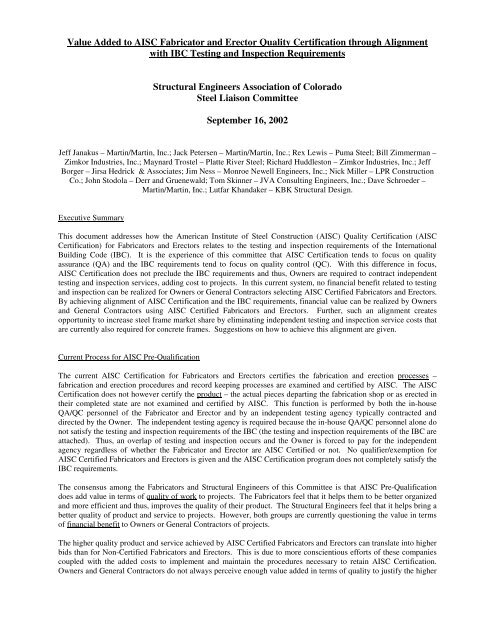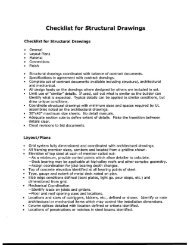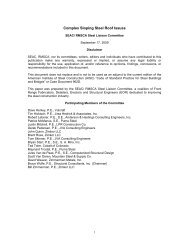AISC Qualification Certification - Rocky Mountain Steel Construction ...
AISC Qualification Certification - Rocky Mountain Steel Construction ...
AISC Qualification Certification - Rocky Mountain Steel Construction ...
Create successful ePaper yourself
Turn your PDF publications into a flip-book with our unique Google optimized e-Paper software.
Value Added to <strong>AISC</strong> Fabricator and Erector Quality <strong>Certification</strong> through Alignment<br />
with IBC Testing and Inspection Requirements<br />
Structural Engineers Association of Colorado<br />
<strong>Steel</strong> Liaison Committee<br />
September 16, 2002<br />
Jeff Janakus – Martin/Martin, Inc.; Jack Petersen – Martin/Martin, Inc.; Rex Lewis – Puma <strong>Steel</strong>; Bill Zimmerman –<br />
Zimkor Industries, Inc.; Maynard Trostel – Platte River <strong>Steel</strong>; Richard Huddleston – Zimkor Industries, Inc.; Jeff<br />
Borger – Jirsa Hedrick & Associates; Jim Ness – Monroe Newell Engineers, Inc.; Nick Miller – LPR <strong>Construction</strong><br />
Co.; John Stodola – Derr and Gruenewald; Tom Skinner – JVA Consulting Engineers, Inc.; Dave Schroeder –<br />
Martin/Martin, Inc.; Lutfar Khandaker – KBK Structural Design.<br />
Executive Summary<br />
This document addresses how the American Institute of <strong>Steel</strong> <strong>Construction</strong> (<strong>AISC</strong>) Quality <strong>Certification</strong> (<strong>AISC</strong><br />
<strong>Certification</strong>) for Fabricators and Erectors relates to the testing and inspection requirements of the International<br />
Building Code (IBC). It is the experience of this committee that <strong>AISC</strong> <strong>Certification</strong> tends to focus on quality<br />
assurance (QA) and the IBC requirements tend to focus on quality control (QC). With this difference in focus,<br />
<strong>AISC</strong> <strong>Certification</strong> does not preclude the IBC requirements and thus, Owners are required to contract independent<br />
testing and inspection services, adding cost to projects. In this current system, no financial benefit related to testing<br />
and inspection can be realized for Owners or General Contractors selecting <strong>AISC</strong> Certified Fabricators and Erectors.<br />
By achieving alignment of <strong>AISC</strong> <strong>Certification</strong> and the IBC requirements, financial value can be realized by Owners<br />
and General Contractors using <strong>AISC</strong> Certified Fabricators and Erectors. Further, such an alignment creates<br />
opportunity to increase steel frame market share by eliminating independent testing and inspection service costs that<br />
are currently also required for concrete frames. Suggestions on how to achieve this alignment are given.<br />
Current Process for <strong>AISC</strong> Pre-<strong>Qualification</strong><br />
The current <strong>AISC</strong> <strong>Certification</strong> for Fabricators and Erectors certifies the fabrication and erection processes –<br />
fabrication and erection procedures and record keeping processes are examined and certified by <strong>AISC</strong>. The <strong>AISC</strong><br />
<strong>Certification</strong> does not however certify the product – the actual pieces departing the fabrication shop or as erected in<br />
their completed state are not examined and certified by <strong>AISC</strong>. This function is performed by both the in-house<br />
QA/QC personnel of the Fabricator and Erector and by an independent testing agency typically contracted and<br />
directed by the Owner. The independent testing agency is required because the in-house QA/QC personnel alone do<br />
not satisfy the testing and inspection requirements of the IBC (the testing and inspection requirements of the IBC are<br />
attached). Thus, an overlap of testing and inspection occurs and the Owner is forced to pay for the independent<br />
agency regardless of whether the Fabricator and Erector are <strong>AISC</strong> Certified or not. No qualifier/exemption for<br />
<strong>AISC</strong> Certified Fabricators and Erectors is given and the <strong>AISC</strong> <strong>Certification</strong> program does not completely satisfy the<br />
IBC requirements.<br />
The consensus among the Fabricators and Structural Engineers of this Committee is that <strong>AISC</strong> Pre-<strong>Qualification</strong><br />
does add value in terms of quality of work to projects. The Fabricators feel that it helps them to be better organized<br />
and more efficient and thus, improves the quality of their product. The Structural Engineers feel that it helps bring a<br />
better quality of product and service to projects. However, both groups are currently questioning the value in terms<br />
of financial benefit to Owners or General Contractors of projects.<br />
The higher quality product and service achieved by <strong>AISC</strong> Certified Fabricators and Erectors can translate into higher<br />
bids than for Non-Certified Fabricators and Erectors. This is due to more conscientious efforts of these companies<br />
coupled with the added costs to implement and maintain the procedures necessary to retain <strong>AISC</strong> <strong>Certification</strong>.<br />
Owners and General Contractors do not always perceive enough value added in terms of quality to justify the higher
ids. This is particularly true if independent testing and inspection costs are required for certified or non-certified<br />
either Fabricators and Erectors. The Structural Engineer of Record for the project can recommend that the<br />
Fabricator and Erector be <strong>AISC</strong> Certified, but ultimately the Owner and/or General Contractor has the final say if<br />
the Building Department does not specifically mandate it. Most Building Departments (exceptions include<br />
governmental agencies) do not mandate and hold to such requirements and thus, for many projects, the requirement<br />
for <strong>AISC</strong> Certified Fabricators and Erectors is non-existent in the project specifications or waived.<br />
Proposed New Process<br />
Many Owners and General Contractors perceive value in terms of financial gain rather than in terms of quality of the<br />
product. A way for these Owners and General Contractors to realize value in <strong>AISC</strong> <strong>Certification</strong> is for the program<br />
to certify the product in addition to certifying the process in a manner that is aligned with the testing and inspection<br />
requirements of the IBC. Under such a process, the testing and inspection requirements of the IBC could be waived<br />
and associated costs eliminated for <strong>AISC</strong> Certified Fabricators and Erectors, allowing the total cost to the Owner for<br />
the fabrication, erection, and testing and inspection of the steel to be decreased. Similar testing and inspection<br />
service requirements are also required for pre-cast and cast-in-place concrete structures. By eliminating the costs of<br />
these services for steel structures, opportunity to grow steel market share is created by offering a more cost-effective<br />
choice for Owners and General Contractors.<br />
Suggestions on How to Implement the New Process<br />
First, <strong>AISC</strong> could open continuous discussions with IBC on this topic. Establishing a line of communication<br />
between the two entities to come to an agreement on how <strong>AISC</strong> <strong>Certification</strong> can align with the IBC testing and<br />
inspection requirements is advantageous. One method of achieving this alignment is for <strong>AISC</strong> to perform or<br />
contract an independent company to perform unannounced spot inspections (independent of the current ASIC<br />
<strong>Certification</strong> audit inspections performed by <strong>AISC</strong>) of fabrication shops and project sites to certify the product. For<br />
fabrication shop inspections, perhaps 2 to 4 times per year would suffice. For project sites, perhaps once or twice<br />
every two weeks would suffice. The repetition of the inspections would likely depend on a number of factors<br />
including the size and complexity of projects and what IBC finds satisfactory. Another method is to have QA/QC<br />
personnel that are paid for by the Fabricator and Erector but that are qualified/certified/monitored by <strong>AISC</strong> or their<br />
auditing company. Perhaps the “Structural Inspector” or a new position developed by <strong>AISC</strong> could be utilized in this<br />
manner.<br />
To offset the additional time constraint and inevitable increases in <strong>AISC</strong> <strong>Certification</strong> fees to obtain this product<br />
certification, perhaps the current yearly audits are adjusted to be every other year. Further, to solve testing and<br />
inspection disputes, perhaps an arbitration process that does not directly involve the main office of <strong>AISC</strong> could be<br />
developed.<br />
Additionally, based on this committee’s experience, a general education for Owners, General Contractors,<br />
Architects, and Structural Engineers on how <strong>AISC</strong> Pre-<strong>Qualification</strong> is obtained and what it means to fabrication<br />
and erection procedures and product quality currently seems to be lacking in the industry. If such education can be<br />
delivered along with an alignment of the <strong>AISC</strong> Pre-<strong>Qualification</strong> process and the IBC testing and inspection<br />
requirements, both the quality and financial values offered to projects can become more evident and in turn, make<br />
steel more competitive and grow market share.







